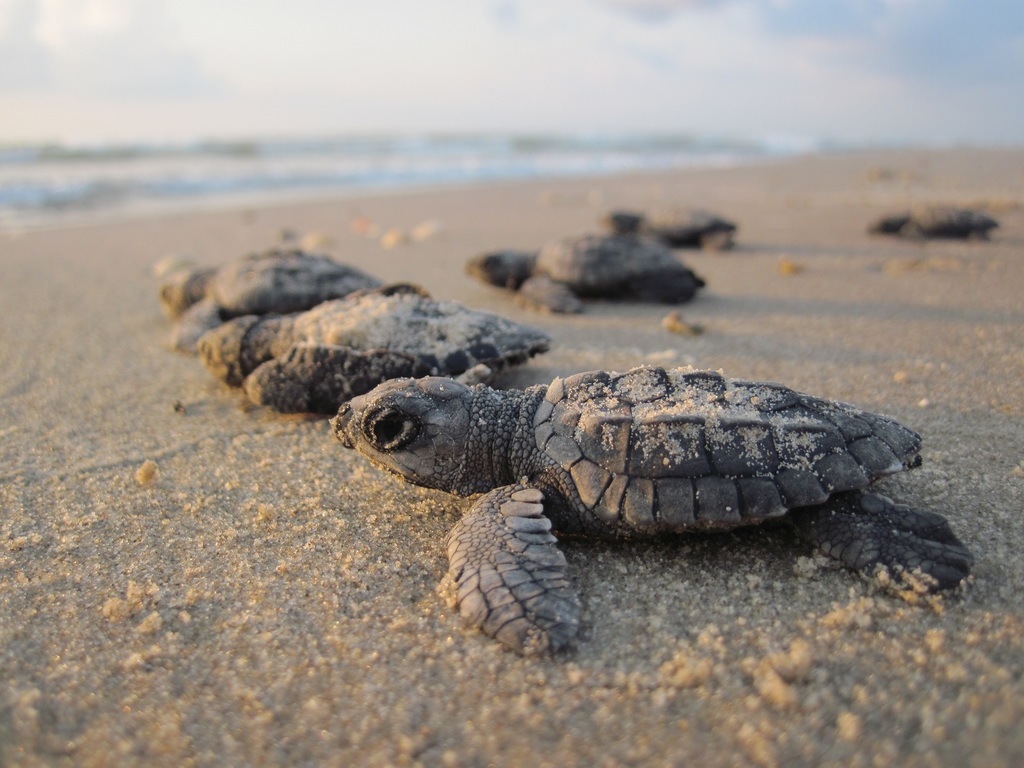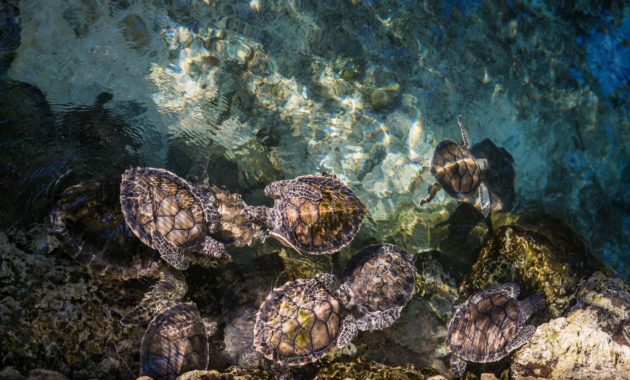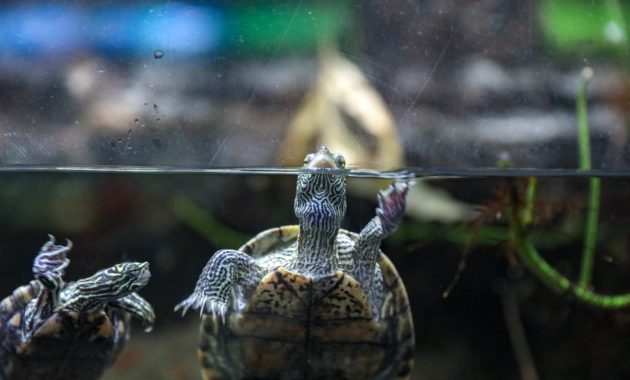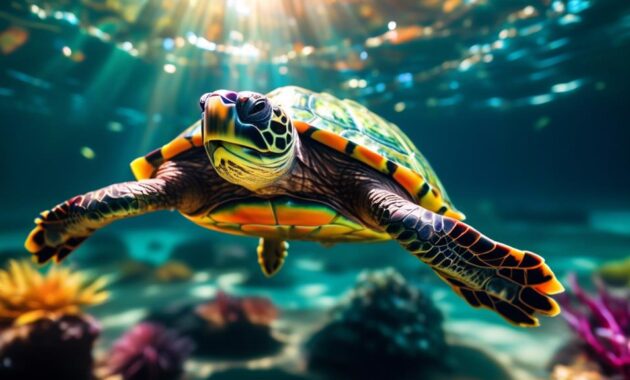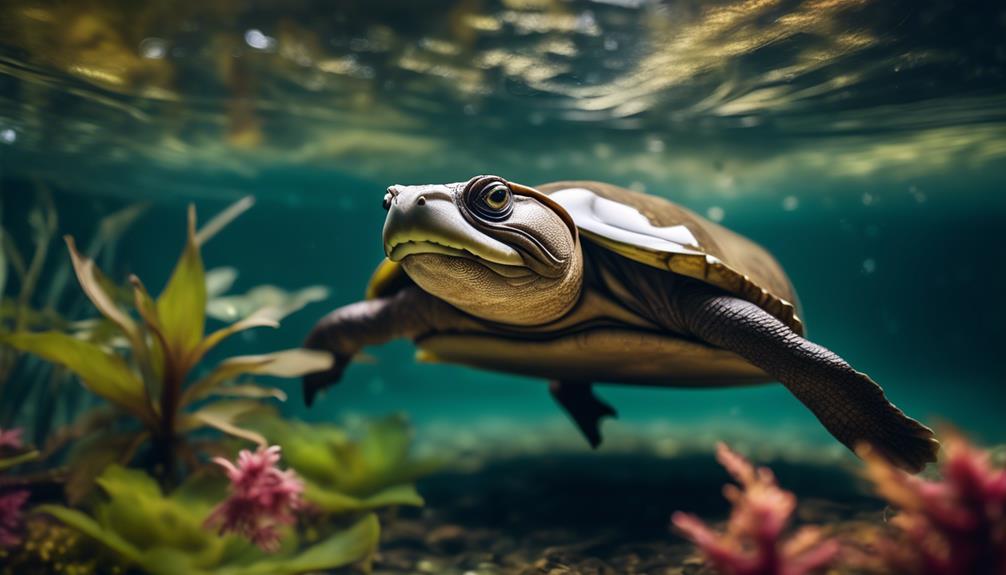
Are you ready to embark on a journey into the fascinating world of aquatic giants?
Prepare to be amazed by the Florida Softshell Turtles – magnificent creatures that possess an impressive lifespan. These aquatic wonders, with their substantial size and webbed feet, effortlessly glide through their watery domain.
But what truly sets them apart is their extraordinary longevity. With the ability to live for over 30 years, these turtles have secrets to share that will captivate your curiosity.
So, get ready to dive into the depths and uncover the remarkable story of the Florida Softshell Turtles.
Key Takeaways
- Florida Softshell Turtles are one of the largest turtles in North America, known for their impressive size and longevity.
- They have adaptations such as webbed feet, which make them efficient swimmers and enable them to hunt for prey and escape from predators effectively.
- Proper care and a well-maintained habitat are essential for their longevity, and they have specific requirements that make them more suitable for experienced turtle owners.
- Their diet consists of small fish, insects, and non-toxic aquatic plants, and a balanced and varied diet is important to meet their nutritional needs.
Size and Adaptations
Florida Softshell Turtles are renowned for their impressive size and their remarkable adaptations for life in water. These turtles can grow to a significant length, making them one of the biggest turtles in North America.
With their webbed feet, they’re well-suited for an aquatic environment and spend most of their time in water. Their large size and webbed feet allow them to navigate through the water with ease, making them efficient swimmers. These adaptations enable them to hunt for prey and escape from predators effectively.
The Florida Softshell Turtles’ size and adaptations for life in water make them unique and fascinating creatures in the animal kingdom.
Lifespan and Longevity
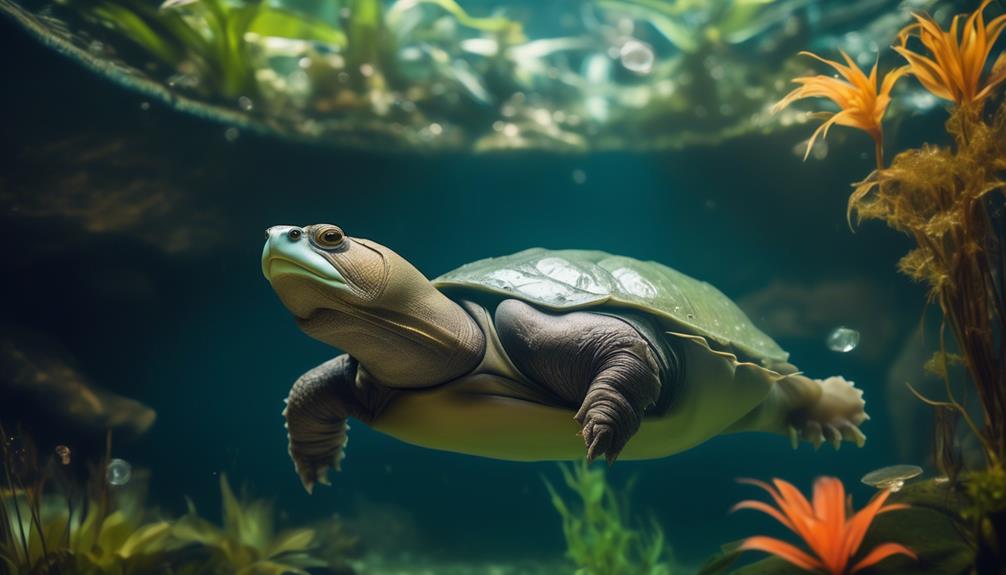
With their impressive adaptations and size, it’s no wonder that the Florida Softshell Turtles have a long lifespan and are known for their longevity. These aquatic giants can live for over 30 years with proper care. They’re considered a long-lived species and can reach a ripe old age.
To ensure their longevity, it’s essential to provide them with the necessary care and a well-maintained habitat. These turtles have specific requirements and aren’t recommended for novice turtle owners. However, for those willing to invest the time and effort, the reward is a fascinating companion that can bring joy for many years.
Diet and Feeding Habits
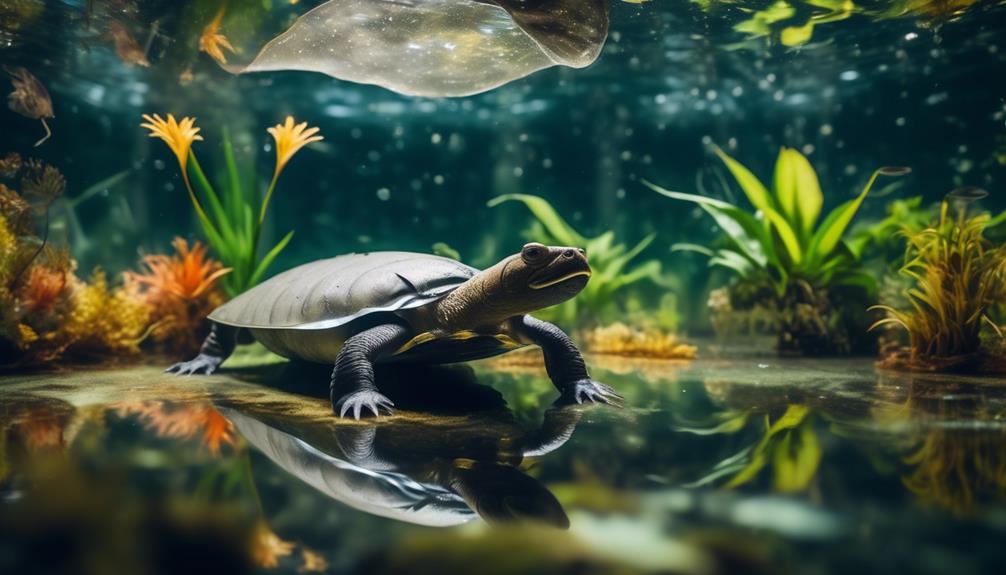
To ensure the health and well-being of Florida Softshell Turtles, it’s important to understand their diet and feeding habits.
These turtles have an omnivorous diet, meaning they consume both animal and plant matter. Their diet primarily consists of small fish, insects, and non-toxic aquatic plants. They use their webbed feet to swim and hunt for prey in the water.
In addition to their natural diet, Florida Softshell Turtles can also be fed commercial turtle diets, which provide them with the necessary nutrients they need to thrive. It’s important to provide a balanced and varied diet to meet their nutritional needs.
Care Requirements
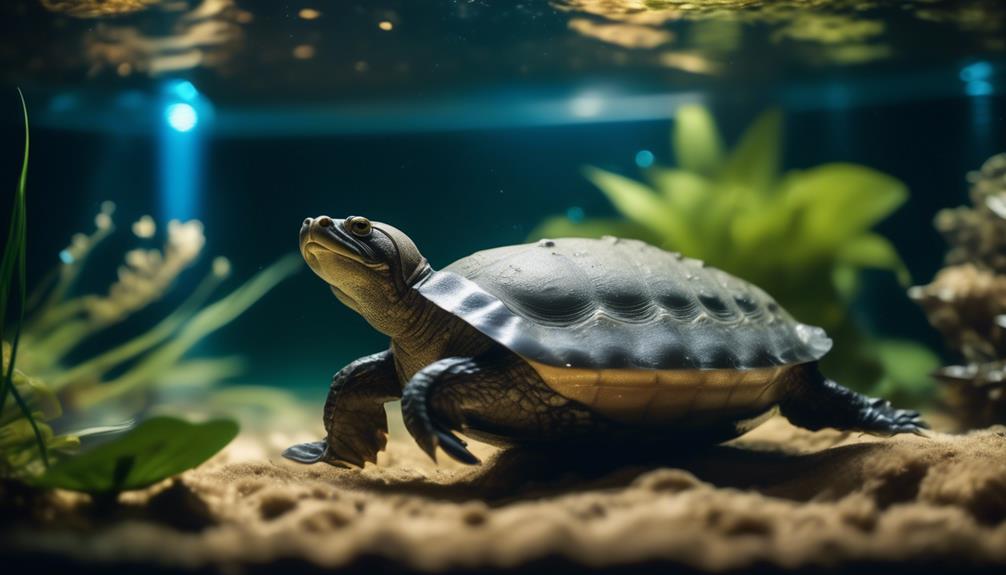
Taking proper care of Florida Softshell Turtles is essential for their well-being and longevity. To ensure they thrive, it’s important to meet their specific care requirements:
- Habitat:
- Provide a spacious tank or pond with both land and water areas.
- Maintain clean and filtered water to prevent infections.
- Diet and Nutrition:
- Offer a balanced diet consisting of commercial turtle pellets, live or frozen fish, insects, and leafy greens.
- Provide calcium and vitamin supplements to support their shell and overall health.
- Environmental Conditions:
- Maintain a water temperature between 75-85°F and a basking area temperature of 85-95°F.
- Use a UVB light to provide the necessary UV radiation for their shell health.
Unique Characteristics
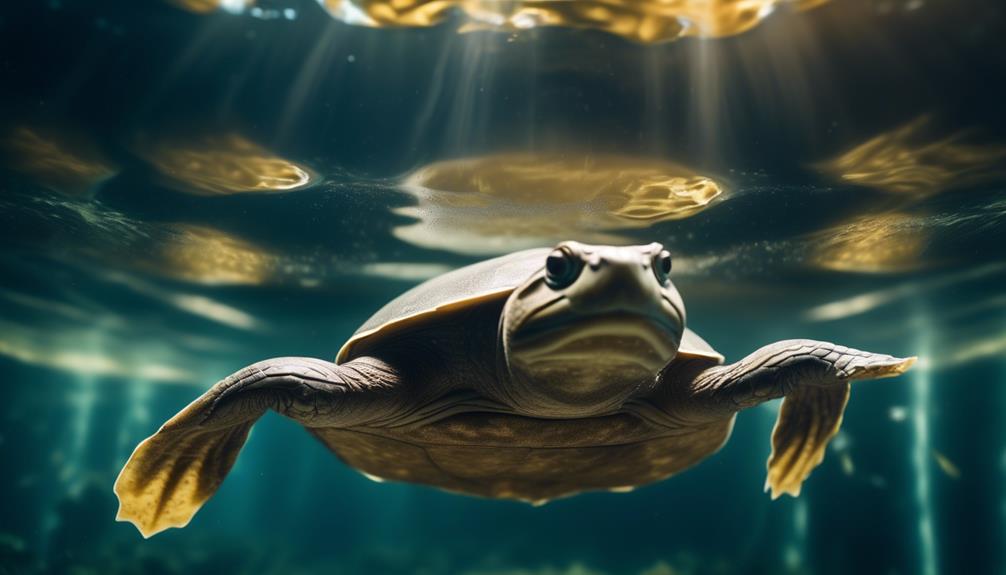
Florida Softshell Turtles possess unique characteristics that set them apart from other turtle species.
One of their standout features is their substantial size. These turtles can grow to a significant length, making them one of the largest turtles in North America.
Another distinguishing characteristic is their adaptation for life in water. With their webbed feet, they’re perfectly suited for an aquatic environment. Unlike many other turtles, Florida Softshell Turtles spend the majority of their time in the water.
Additionally, these turtles are known for their impressive longevity. With a lifespan of over 30 years, they’re considered a long-lived species.
Their omnivorous diet, consisting of small fish, insects, and non-toxic aquatic plants, further adds to their uniqueness.
To thrive, Florida Softshell Turtles require high maintenance and specific care.
Habitat and Environment
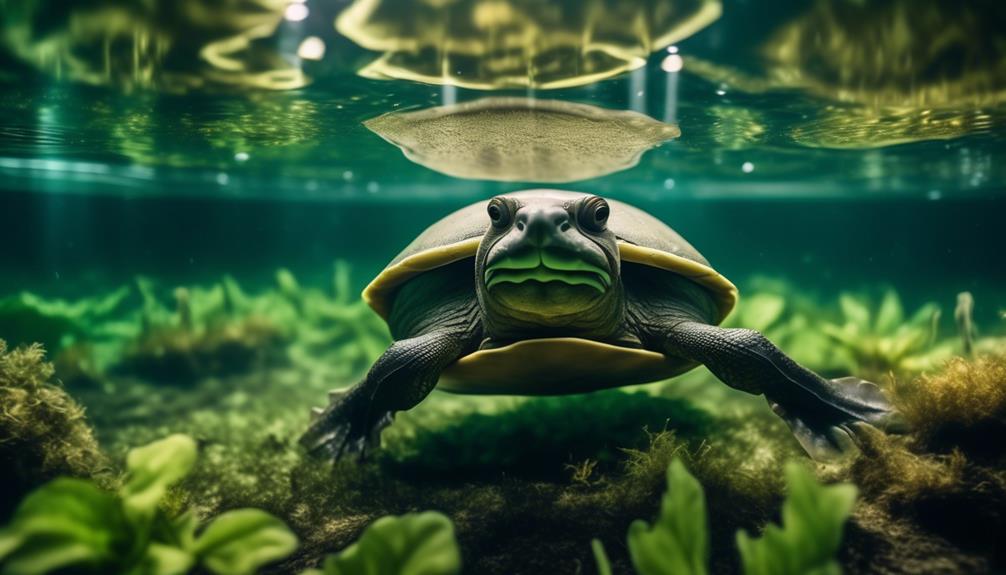
The habitat and environment of Florida Softshell Turtles play a crucial role in their overall well-being and survival. Here are some important factors to consider:
- Aquatic Environment
- Florida Softshell Turtles are well-adapted for life in water.
- They’ve webbed feet that allow them to swim easily.
- These turtles spend most of their time in aquatic habitats such as rivers, lakes, and swamps.
- Specific Habitat Requirements
- They prefer habitats with sandy or muddy bottoms.
- It’s important for them to have access to both deep water for swimming and shallow areas for basking.
- Aquatic vegetation is also necessary for their survival.
Reproduction and Offspring
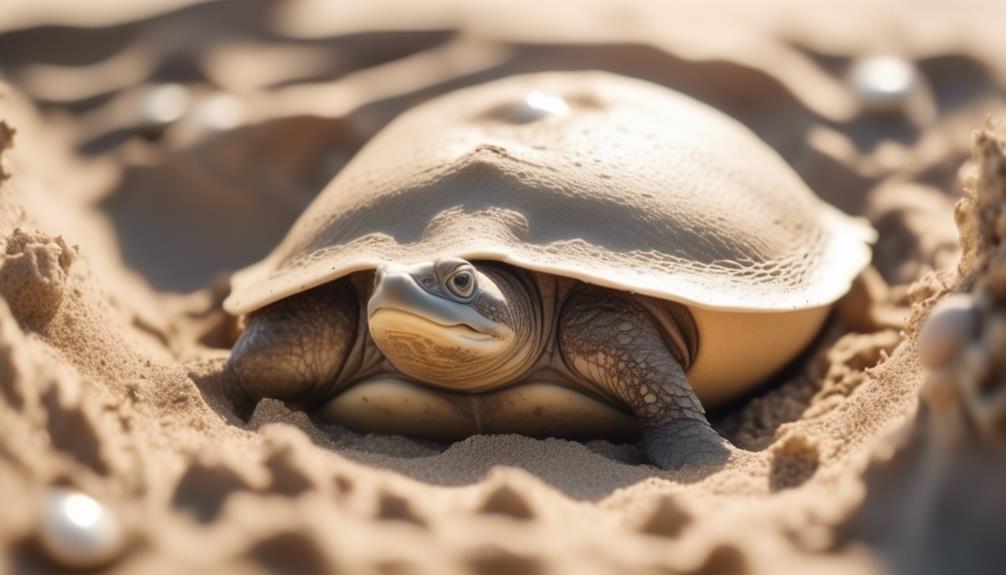
Reproduction and the birth of offspring are significant milestones in the life cycle of Florida Softshell Turtles. These turtles reach sexual maturity at around 7 to 10 years of age.
During the mating season, males will actively pursue females, often engaging in aggressive behavior to secure a mate. The courtship involves males swimming around the female and sometimes biting her shell or limbs. Once the female has selected a mate, she’ll lay her eggs in a nest dug in sandy soil near the water’s edge.
The number of eggs laid can vary, but a typical clutch consists of 10 to 30 eggs. The incubation period lasts about 70 to 80 days, after which the hatchlings emerge and make their way to the water. The survival rate for these young turtles can be low, as they face numerous predators. However, those that do survive have the potential to live long and fulfilling lives in the water.
Threats and Conservation Status
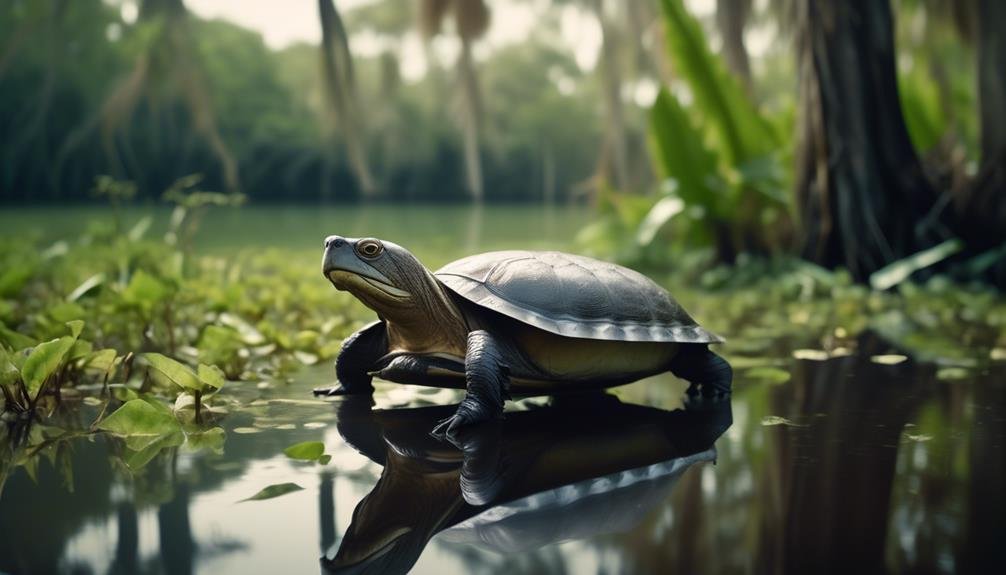
Threats to the Florida Softshell Turtles and their conservation status are important considerations for their long-term survival. These majestic creatures face numerous challenges in their natural habitat.
Threats:
- Habitat Loss: The destruction and degradation of aquatic habitats due to urbanization, agriculture, and pollution threaten the softshell turtles’ survival.
- Nest Predation: Predators, such as raccoons and foxes, pose a significant threat to Florida Softshell Turtle eggs, reducing their chances of hatching successfully.
Conservation Status:
- Endangered Species: The Florida Softshell Turtle is listed as a species of special concern in Florida due to declining populations and habitat loss.
- Protected by Law: These turtles are protected by state and federal regulations, making it illegal to harm, capture, or trade them without proper permits.
Efforts are underway to mitigate these threats and conserve the Florida Softshell Turtles through habitat restoration, public education, and conservation programs. Continued conservation efforts are crucial to ensure the survival of this remarkable species.
Interaction With Humans
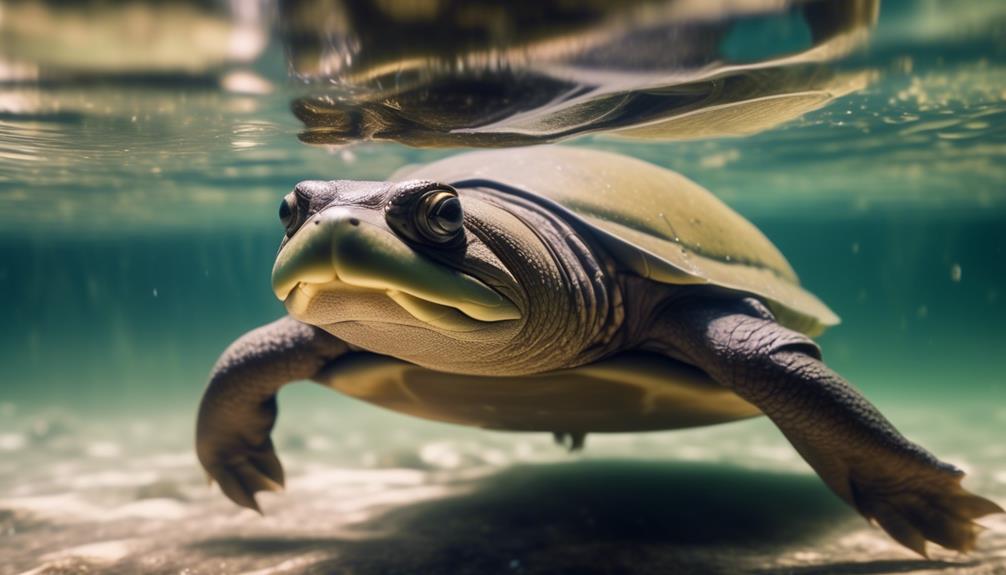
After discussing the threats and conservation status of Florida Softshell Turtles, it’s important to consider their interaction with humans and the impact it has on their survival. Humans have a significant influence on the well-being of these turtles.
One of the major threats they face is habitat loss due to urban development and pollution. As humans encroach upon their natural habitats, the turtles are left with limited space to live and reproduce.
Additionally, the pet trade poses a threat to their survival. Softshell turtles are often captured and sold as pets, leading to a decline in their wild populations.
It’s crucial for humans to be mindful of the impact they have on these turtles and to take measures to protect their habitats and refrain from capturing them from the wild.
Frequently Asked Questions
What Is the Average Size of a Florida Softshell Turtle?
The average size of a Florida Softshell Turtle is significant. They can grow to be one of the biggest turtles in North America. Their large size is one of their distinguishing characteristics.
How Do Florida Softshell Turtles Catch Their Prey?
Florida Softshell Turtles catch their prey by using their sharp beaks and powerful jaws. They are skilled hunters in the water, relying on their agility and speed to capture small fish and insects.
Can Florida Softshell Turtles Survive in a Habitat Without Water?
No, Florida Softshell Turtles cannot survive in a habitat without water. They are adapted for an aquatic environment and spend most of their time in water. Without water, they would not be able to thrive.
Do Florida Softshell Turtles Require Any Specific Temperature or Lighting Conditions in Their Habitat?
Yes, Florida Softshell Turtles require specific temperature and lighting conditions in their habitat. They need a warm basking area with UVB lighting to mimic their natural environment and maintain their health.
What Are the Most Common Threats to Florida Softshell Turtles in Their Natural Environment?
The most common threats to Florida Softshell Turtles in their natural environment include habitat loss, pollution, and predation. It’s important to protect their habitats and minimize human impact to ensure their survival.
What is the Lifespan of Florida Softshell Turtles Compared to Smooth Softshell Turtles?
The lifespan of Florida softshell turtles is commonly around 10-15 years, while smooth softshell turtles can live up to 50 years. Both species face predators such as raccoons, birds, and larger fish. However, their ability to live longer gives smooth softshell turtles an advantage in navigating these predators over the years.
Conclusion
In conclusion, caring for Florida Softshell Turtles requires dedication and commitment due to their high maintenance needs. These aquatic giants are renowned for their substantial size and impressive lifespan of over 30 years.
With their adaptability to an omnivorous diet and well-maintained habitat, they can thrive and live a long and fulfilling life. However, their specific care requirements make them a challenge for novice turtle owners.
Overall, the Florida Softshell Turtles are fascinating creatures that truly test one’s dedication and love for aquatic life.

